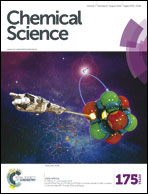Bromide promoted hydrogenation of CO2 to higher alcohols using Ru–Co homogeneous catalyst†
Abstract
Iodides are commonly used promoters in C2+OH synthesis from CO2/CO hydrogenation. Here we report the highly efficient synthesis of C2+OH from CO2 hydrogenation over a Ru3(CO)12–Co4(CO)12 bimetallic catalyst with bis(triphenylphosphoranylidene)ammonium chloride (PPNCl) as the cocatalyst and LiBr as the promoter. Methanol, ethanol, propanol and isobutanol were formed at milder conditions. The catalytic system had a much better overall performance than those of reported iodide promoted systems because PPNCl and LiBr cooperated very well in accelerating the reaction. LiBr enhanced the activity and PPNCl improved the selectivity, and thus both the activity and selectivity were very high when both of them were used simultaneously. In addition, the catalyst could be reused for at least five cycles without an obvious change of catalytic performance.


 Please wait while we load your content...
Please wait while we load your content...